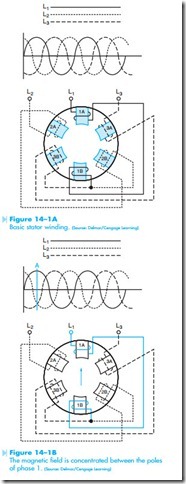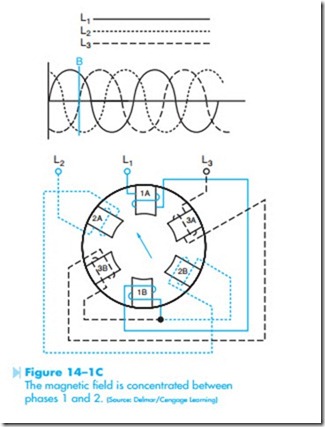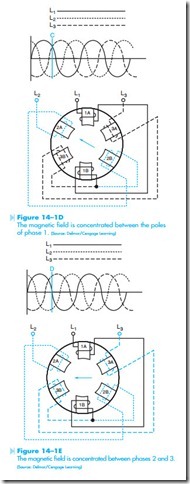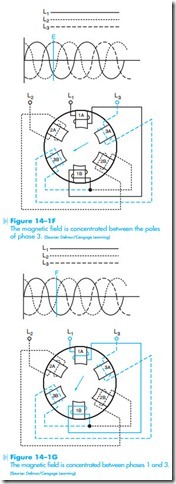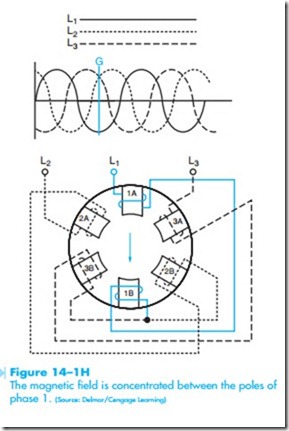Three-Phase Motor Principles
There are three basic types of three-phase motors. These are:
1. The squirrel-cage induction motor.
2. The wound rotor induction motor.
3. The synchronous motor.
The type of three-phase motor is determined by the rotor or rotating member. The stator windings for any of these motors is the same. In this unit, the basic principles of operation for three-phase motors will be discussed.
The principle of operation for all three-phase motors is the rotating magnetic field. There are three factors that cause the magnetic field to rotate. These are:
1. The voltages of a three-phase system are 120° out of phase with each other.
2. The three voltages change polarity at regular intervals.
3. The arrangement of the stator windings
Figure 14–1A shows three AC voltages 120° out of phase with each other, and the stator winding of a three-phase motor. The stator illustrates a two- pole, three-phase motor. Two-pole means that there are two poles per phase. AC motors do not generally have actual pole pieces as shown in Figure 14–1A, but they will be used here to aid in understanding how the rotating magnetic field is created in a three- phase motor. Notice that pole pieces 1A and 1B are located opposite each other. The same is true for poles 2A and 2B, and 3A and 3B. The pole pieces 1A and 1B are wound with wire that is connected to phase one of the three-phase system. Notice also that the pole pieces are wound in such a manner that they will always have opposite magnetic polarities. If pole piece 1A has a north magnetic polarity, pole piece 1B will have a south magnetic polarity at the same time.
The windings of pole pieces 2A and 2B are connected to line 2 of the three-phase system. The windings of pole pieces 3A and 3B are connected to line 3 of the three-phase system. These pole pieces are also wound in such a manner as to have the opposite polarity of magnetism.
To understand how the magnetic field rotates around the inside of the motor, refer to Figure 14–1B. Notice a line, labeled “A,” has been drawn through the three voltages of the system. This line is used to illustrate the condition of the three voltages at this point in time. The arrow drawn inside the motor indicates the greatest strength of the magnetic field at the same point in time. It is to be assumed that the arrow is pointing in the direction of the north magnetic field. Notice in Figure 14–1B, that phase 1 is at its maximum positive peak, and that phases 2 and 3 are less than maximum. The magnetic field is, therefore, strongest between pole pieces 1A and 1B.
In Figure 14–1C, line B indicates that the voltage of line 3 is zero. The voltage of line 1 is less than maxi- mum positive; and line 2 is less than maximum negative. The magnetic field at this point is concentrated between the pole pieces of phase 1 and phase 2.
In Figure 14–1D, line C indicates that line 2 is at its maximum negative peak and that lines 1 and 3 are less than maximum positive. The magnetic field at this point is concentrated between pole pieces 2A and 2B.
In Figure 14–1E, line D indicates that line 1 is zero. Lines 2 and 3 are less than maximum and in opposite directions. At this point, the magnetic field is concentrated between the pole pieces of phase 2 and phase 3.
In Figure 14–1F, line E indicates that phase 3 is at its maximum positive peak and lines 1 and 2 are less than maximum and in the opposite direction. The magnetic field at this point is concentrated between pole pieces 3A and 3B.
In Figure 14–1G, line F indicates that phase 2 is 0. Line 3 is less than maximum positive; and line 1 is less than maximum negative. The magnetic field at this time is concentrated between the pole pieces of phase 1 and phase 3.
In Figure 14–1H, line G indicates that phase 1 is at its maximum negative peak; and phase 2 and 3 are less than maximum and in the opposite direction. Notice that the magnetic field is again concentrated between pole pieces 1A and 1B. This time, however, the magnetic polarity is reversed because the current has reversed in the stator winding.
In Figure 14–1I, line H indicates phase 2 is at its maximum positive peak and phases 1 and 3 are less than maximum and in the negative direction. The magnetic field is concentrated between pole pieces 2A and 2B.
In Figure 14–1J, line 1 indicates that phase 3 is maximum negative; and phases 1 and 2 are less than maximum in the positive direction. The magnetic field at this point is concentrated between pole pieces 3A and 3B.
In Figure 14–1K, line J indicates that phase 1 is at its positive peak; and phases 2 and 3 are less than maximum and in the opposite direction. The
magnetic field is again concentrated between pole pieces 1A and 1B. Notice that in one complete cycle of three-phase voltage, the magnetic field has rotated 360° around the inside of the stator winding.
If any two of the stator leads is connected to a different line, the relationship of the voltages will change and the magnetic field will rotate in the opposite direction. The direction of rotation of a three-phase motor can be reversed by changing any two stator leads.
